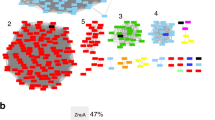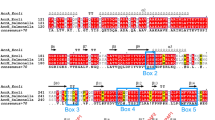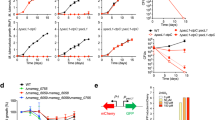Abstract
Gram-negative bacteria, such as Escherichia coli, frequently use tripartite efflux complexes in the resistance-nodulation-cell division (RND) family to expel various toxic compounds from the cell1,2. The efflux system CusCBA is responsible for extruding biocidal Cu(I) and Ag(I) ions3,4. No previous structural information was available for the heavy-metal efflux (HME) subfamily of the RND efflux pumps. Here we describe the crystal structures of the inner-membrane transporter CusA in the absence and presence of bound Cu(I) or Ag(I). These CusA structures provide new structural information about the HME subfamily of RND efflux pumps. The structures suggest that the metal-binding sites, formed by a three-methionine cluster, are located within the cleft region of the periplasmic domain. This cleft is closed in the apo-CusA form but open in the CusA-Cu(I) and CusA-Ag(I) structures, which directly suggests a plausible pathway for ion export. Binding of Cu(I) and Ag(I) triggers significant conformational changes in both the periplasmic and transmembrane domains. The crystal structure indicates that CusA has, in addition to the three-methionine metal-binding site, four methionine pairs—three located in the transmembrane region and one in the periplasmic domain. Genetic analysis and transport assays suggest that CusA is capable of actively picking up metal ions from the cytosol, using these methionine pairs or clusters to bind and export metal ions. These structures suggest a stepwise shuttle mechanism for transport between these sites.
This is a preview of subscription content, access via your institution
Access options
Subscribe to this journal
Receive 51 print issues and online access
$199.00 per year
only $3.90 per issue
Buy this article
- Purchase on Springer Link
- Instant access to full article PDF
Prices may be subject to local taxes which are calculated during checkout





Similar content being viewed by others
References
Tseng, T. T. et al. The RND permease superfamily: an ancient, ubiquitous and diverse family that includes human disease and development protein. J. Mol. Microbiol. Biotechnol. 1, 107–125 (1999)
Nies, D. H. Efflux-mediated heavy metal resistance in prokaryotes. FEMS Microbiol. Rev. 27, 313–339 (2003)
Franke, S., Grass, G. & Nies, D. H. The product of the ybdE gene of the Escherichia coli chromosome is involved in detoxification of silver ions. Microbiology 147, 965–972 (2001)
Franke, S., Grass, G., Rensing, C. & Nies, D. H. Molecular analysis of the copper-transporting efflux system CusCFBA of Escherichia coli . J. Bacteriol. 185, 3804–3812 (2003)
Murakami, S., Nakashima, R., Yamashita, E. & Yamaguchi, A. Crystal structure of bacterial multidrug efflux transporter AcrB. Nature 419, 587–593 (2002)
Yu, E. W., McDermott, G., Zgruskaya, H. I., Nikaido, H. & Koshland, D. E., Jr Structural basis of multiple drug binding capacity of the AcrB multidrug efflux pump. Science 300, 976–980 (2003)
Murakami, S., Nakashima, R., Yamashita, E., Matsumoto, T. & Yamaguchi, A. Crystal structures of a multidrug transporter reveal a functionally rotating mechanism. Nature 443, 173–179 (2006)
Seeger, M. A. et al. Structural asymmetry of AcrB trimer suggests a peristaltic pump mechanism. Science 313, 1295–1298 (2006)
Sennhauser, G., Amstutz, P., Briand, C., Storchengegger, O. & Grütter, M. G. Drug export pathway of multidrug exporter AcrB revealed by DARPin inhibitors. PLoS Biol. 5, e7 (2007)
Yu, E. W., Aires, J. R., McDermott, G. & Nikaido, H. A periplasmic-drug binding site of the AcrB multidrug efflux pump: a crystallographic and site-directed mutagenesis study. J. Bacteriol. 187, 6804–6815 (2005)
Su, C.-C. et al. Conformation of the AcrB multidrug efflux pump in mutants of the putative proton relay pathway. J. Bacteriol. 188, 7290–7296 (2006)
Sennhauser, G., Bukowska, M. A., Briand, C. & Grütter, M. G. Crystal structure of the multidrug exporter MexB from Pseudomonas aeruginosa . J. Mol. Biol. 389, 134–145 (2009)
Koronakis, V., Sharff, A., Koronakis, E., Luisi, B. & Hughes, C. Crystal structure of the bacterial membrane protein TolC central to multidrug efflux and protein export. Nature 405, 914–919 (2000)
Akama, H. et al. Crystal structure of the drug discharge outer membrane protein, OprM, of Pseudomonas aeruginosa . J. Biol. Chem. 279, 52816–52819 (2004)
Mikolosko, J., Bobyk, K., Zgurskaya, H. I. & Ghosh, P. Conformational flexibility in the multidrug efflux system protein AcrA. Structure 14, 577–587 (2006)
Higgins, M. K., Bokma, E., Koronakis, E., Hughes, C. & Koronakis, V. Structure of the periplasmic component of a bacterial drug efflux pump. Proc. Natl Acad. Sci. USA 101, 9994–9999 (2004)
Akama, H. et al. Crystal structure of the membrane fusion protein, MexA, of the multidrug transporter in Pseudomonas aeruginosa . J. Biol. Chem. 279, 25939–25942 (2004)
Symmons, M., Bokma, E., Koronakis, E., Hughes, C. & Koronakis, V. The assembled structure of a complete tripartite bacterial multidrug efflux pump. Proc. Natl Acad. Sci. USA 106, 7173–7178 (2009)
Su, C.-C. et al. Crystal structure of the membrane fusion protein CusB from Escherichia coli . J. Mol. Biol. 393, 342–355 (2009)
Zhou, H. & Thiele, D. J. Identification of a novel high affinity copper transport complex in the fission yeast Schizosaccharomyces pombe . J. Biol. Chem. 276, 20529–20535 (2001)
Jiang, J., Nadas, I. A., Kim, M. A. & Franz, K. J. A Mets motif peptide found in copper transport proteins selectively binds Cu(I) with methionine-only coordination. Inorg. Chem. 44, 9787–9794 (2005)
Banci, L. et al. The Atx1–Ccc2 complex is a metal-mediated protein–protein interaction. Nature Chem. Biol. 2, 367–368 (2006)
Xue, Y. et al. Cu(I) recognition via cation-π and methionine interactions in CusF. Nature Chem. Biol. 4, 107–109 (2008)
Loftin, I. R., Franke, S., Blackburn, N. J. & McEvoy, M. M. Unusual Cu(I)/Ag(I) coordination of Escherichia coli CusF as revealed by atomic resolution crystallography and x-ray absorption spectroscopy. Protein Sci. 16, 2287–2293 (2007)
Changela, A. et al. Molecular basis of metal-ion selectivity and zeptomolar sensitivity by CueR. Science 301, 1383–1387 (2003)
Arnesano, F., Banci, L., Bertini, I., Huffman, D. L. & O’Halloran, T. V. Solution structure of the Cu(I) and apo-forms of the yeast metallochaperone, Atx1. Biochemistry 40, 1528–1539 (2001)
Atilgan, A. R. et al. Anisotropy of fluctuation dynamics of proteins with an elastic network model. Biophys. J. 80, 505–515 (2001)
Goldberg, M., Pribyl, T., Juhuke, S. & Nies, D. H. Energetics and topology of CzcA, a cation/proton antiporter of the resistance-nodulation-cell division protein family. J. Biol. Chem. 274, 26065–26070 (1999)
Aires, J. R. & Nikaido, H. Aminoglycosides are captured from both periplasm and cytoplasm by the AcrD multidrug efflux transporter of Escherichia coli . J. Bacteriol. 187, 1923–1929 (2005)
Otwinowski, Z. & Minor, M. Processing of X-ray diffraction data collected in oscillation mode. Methods Enzymol. 276, 307–326 (1997)
Schneider, T. R. & Sheldrick, G. M. Substructure solution with SHELXD. Acta Crystallogr. D 58, 1772–1779 (2002)
Pape, T. & Schneider, T. R. HKL2MAP: a graphical user interface for macromolecular phasing with SHELX programs. J. Appl. Cryst. 37, 843–844 (2004)
Otwinowski, Z. MLPHARE, CCP4 Proc. 80 (Daresbury Laboratory, 1991)
Collaborative Computational Project No. 4. The CCP4 suite: programs for protein crystallography. Acta Crystallogr. D 50, 760–763 (1994)
Terwilliger, T. C. Maximum-likelihood density modification using pattern recognition of structural motifs. Acta Crystallogr. D 57, 1755–1762 (2001)
Emsley, P. & Cowtan, K. Coot: model-building tools for molecular graphics. Acta Crystallogr. D 60, 2126–2132 (2004)
Adams, P. D. et al. PHENIX: building new software for automated crystallographic structure determination. Acta Crystallogr. 58, 1948–1954 (2002)
Brünger, A. T. et al. Crystallography & NMR system: a new software suite for macromolecular structure determination. Acta Crystallogr. D 54, 905–921 (1998)
McCoy, A. J. et al. Phaser crystallographic software. J. Appl. Cryst. 40, 658–674 (2007)
Gabb, H. A., Jackson, R. M. & Sternberg, M. J. E. Modelling protein docking using shape complementarity, electrostatics, and biochemical information. J. Mol. Biol. 272, 106–120 (1997)
Katchalski-Katzir, E. et al. Molecular surface recognition: determination of geometric fit between proteins and their ligands by correlation techniques. Proc. Natl Acad. Sci. USA 89, 2195–2199 (1992)
Phillips, J. C. et al. Scalable molecular dynamics with NAMD. J. Comput. Chem. 26, 1781–1802 (2005)
Feller, S. E. & MacKerell, A. D., Jr An improved empirical potential energy for molecular simulations of phospholipids. J. Phys. Chem. B 104, 7510–7515 (2000)
Datsenko, K. A. & Wanner, B. L. One-step inactivation of chromosomal genes in Escherichia coli K-12 using PCR products. Proc. Natl Acad. Sci. USA 97, 6640–6645 (2000)
Acknowledgements
We thank M. D. Routh for critical reading of the manuscript. This work is based on research conducted at the Northeastern Collaborative Access Team beamlines of the Advanced Photon Source, supported by National Institutes of Health (NIH) award RR-15301 from the National Center for Research Resources. Use of the Advanced Photon Source is supported by the US Department of Energy, Office of Basic Energy Sciences, under contract no. DE-AC02-06CH11357. This work was supported by NIH grants GM 074027 (to E.W.Y.), GM 086431 (to E.W.Y.), GM 081680 (to R.L.J.) and GM 072014 (to R.L.J.).
Author information
Authors and Affiliations
Contributions
F.L., C.-C.S. and E.W.Y. designed the research. F.L. and C.-C.S. performed experiments. M.T.Z. and S.E.B. performed simulations. C.-C.S., F.L., K.R.R. and E.W.Y. performed model building and refinement. F.L., C.-C.S., R.L.J. and E.W.Y. wrote the paper.
Corresponding author
Ethics declarations
Competing interests
The authors declare no competing financial interests.
Supplementary information
Supplementary Information
This file contains a Supplementary Discussion, Supplementary Figures 1-14 plus legends and Supplementary Tables 1-4. (PDF 17188 kb)
Rights and permissions
About this article
Cite this article
Long, F., Su, CC., Zimmermann, M. et al. Crystal structures of the CusA efflux pump suggest methionine-mediated metal transport. Nature 467, 484–488 (2010). https://doi.org/10.1038/nature09395
Received:
Accepted:
Issue Date:
DOI: https://doi.org/10.1038/nature09395
This article is cited by
-
Insights into the defensive mechanism of bioleaching microorganisms under extreme environmental copper stress
Reviews in Environmental Science and Bio/Technology (2023)
-
Inhibition of direct-electron-transfer-type bioelectrocatalysis of bilirubin oxidase by silver ions
Analytical Sciences (2022)
-
Unique underlying principles shaping copper homeostasis networks
JBIC Journal of Biological Inorganic Chemistry (2022)
-
Structural and functional analysis of the promiscuous AcrB and AdeB efflux pumps suggests different drug binding mechanisms
Nature Communications (2021)
-
Antibiotic export by MexB multidrug efflux transporter is allosterically controlled by a MexA-OprM chaperone-like complex
Nature Communications (2020)
Comments
By submitting a comment you agree to abide by our Terms and Community Guidelines. If you find something abusive or that does not comply with our terms or guidelines please flag it as inappropriate.



